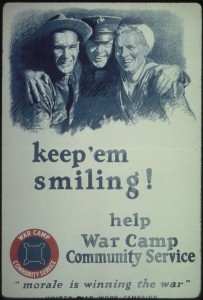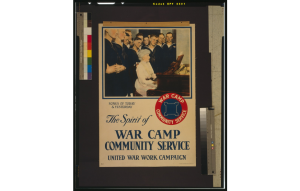
War Camp Community Service was one of only two secular groups involved in the UWWC, the American Library Association being the other. The service was also unique in that it was formed out of a previously-existing organization, the Playground Association of America (PAA). The PAA was heavily involved in issues prior to the war that would become pertinent in WCCS. In order to fully understand the service, one must first examine the PAA.
Playground Association of America
The Playground Association of America was founded in 1906 in Washington, D.C., by Henry Curtis and Luther Gulick.[1] Most of the supporters of the play movement from which the PAA arose were middle to upper class and were involved in other progressive reforms.[2] After one of its first meetings, the leaders of the organization declared that “inasmuch as play under proper conditions is essential to the health and the physical, social and moral well being of the child, playgrounds are a necessity for all children.”[3] This philosophy, originally applied to children, would be extended to American soldiers through the War Camp Community Service in later years.
Motives and Philosophy

Historians have long disputed over the motivations of the PAA. Some have contended that the PAA and other organizations that built public playgrounds did so out of concern that urban youth who had few recourses for amusement would turn to hooliganism.[4] Others have alleged that the play movement sought to make these youth more like Anglo-Protestant America.[5] The PAA, indeed, seems to have had motivations besides philanthropy. Joseph Lee, a key figure in the organization, saw the play movement as a way of training children to be future citizens. He opined in The American Review in 1928 that “Play, to the child is nature’s way of growth, the way she has chosen for making him a man…She has him wrestle and compete and play team games that he may grow up a soldier and citizen.”[6] In that same vein, a 1908 pamphlet authored by Lee portrayed play as “training for adult life.”[7] This idea of recreation and community forming the right type of men, advocated by the PAA, is readily apparent in the War Camp Community Service’s work. The service’s goal of bettering soldiers through recreation and social gathering was certainly an outgrowth of the progressive acculturation that Lee and other PAA leaders sought to create.
War Work
War Camp Community Service first established booths near camps where soldiers could find directions to libraries, gymnasiums, and other “better sources of entertainment.” [8] The service also held community dances and dinners for citizens and soldiers to promote unity and camaraderie between the two. [9] Other WCCS activities included founding citizen and soldier sport leagues, opening swimming pools and organizing patriotic song rallies. [10]
The service also invited soldiers to social, supervised gatherings where young women would be present, which was seen as a way to bolster morale in the men without impropriety. According to Lee, “Our soldiers and sailors will seek and find female society in any case. The War Camp Community Service has provided, for the first time in history, that they shall find it in a form that does them not harm but infinite good.” [11] Wholesome surroundings, relationships and community were the foundation of the service’s philosophy and war work and direct outgrowths of its work as the Playground Association of America.
[1]Sarah Jo Peterson, “Voting for Play: The Democratic Potential of Progressive Era Playgrounds,” The Journal of the Gilded Age and Progressive Era 3, no. 2 (April 1, 2004): 158.
[2]Stephen Hardy and Alan G. Ingham, “Games, Structures, and Agency: Historians on the American Play Movement,” Journal of Social History 17, no. 2 (December 1, 1983): 290.
[3]jhansan, “Playground Association of America: Early Days,” Social Welfare History Project, accessed June 25, 2015, http://www.socialwelfarehistory.com/organizations/playground-association-of-america-earlly-days/.
[4]Hardy and Ingham, “Games, Structures, and Agency: Historians on the American Play Movement,”286.
[5]Hardy and Ingham, “Games, Structures, and Agency: Historians on the American Play Movement,”290.
[6]Joseph Lee, “Play for Young and Old,” The North American Review 226, no. 1 (July 1, 1928): 87–92.
[7]Peterson, “Voting for Play: The Democratic Potential of Progressive Era Playgrounds,”145–75.
[8]Joseph Lee, “War Camp Community Service,” Annals of the American Academy of Political and Social Science 79 (September 1, 1918): 189–94.
[9]Lee, “War Camp Community Service,” Annals of the American Academy of Political and Social Science 79, 189–94.
[10]Rowland Haynes, What New York Did for Fighting Men through New York War Camp Community Service in the World-War of 1917-1919. (New York, 1919), http://hdl.handle.net/2027/loc.ark:/13960/t9z03km1p.
[11]Lee, “War Camp Community Service,” Annals of the American Academy of Political and Social Science 79, 189–94.